I can't begin to count the number of airlines we've flown all over the world but obviously, it's been a few. No other airline but Avianca Airlines that flies all over South America, however, have we seen one trying to actively enforce the carry-on luggage rules. Several times this trip we've seen only female Avianca employees walk through departure lounges toting these cardboard boxes to represent the maximum size of all carry-on items while looking for people who clearly have exceeded the posted limit. This passenger was told he needed to consolidate his items before boarding the plane. I wish all airlines would do that because the number and size of so-called carry-on bags is getting ridiculous in my opinion.
After an early flight from Quito to Cuenca, it was a lovely change having our hotel owner pick us up from the airport in what Lonely Planet referred to as ‘Ecuador’s most seductive colonial city.’ Thought it’s the country’s third largest city, there were only three flights a day in and out of the airport which was just a few minutes from downtown. Flying in and out of the city can’t be easy as a residential area was just a hundred feet from the runway.
Cuenca, founded by the Incas around 1470 when it was
known as Tomebamba was said to rival Peru’s Cusco with its splendor. Its
glory was short-lived because of an Inca civil war in the early years of the 16th
century. The Spaniards then discovered it in 1557.
After dumping our things in our room, we walked past the closed Iglesia San Alfonso toward the main
square, Parque Calderon, in the heart of Cuenca’s colonial center.

The park, which was filled with attractive flowerbeds and tall pine and palm trees, framed the city’s two main religious landmarks, Catedral Nueva and Catedral Vieja.
Never had we
been in a city where there were two cathedrals just a stone’s throw apart. It
seemed that the most distinctive feature of Cuenca would have to be the large
sky-blue domes of the new cathedral.
As we entered the 19th century New Cathedral officially called La Catedral de la Immaculada Concepion, Steven remarked, "Now, THIS is a cathedral!"
The large central nave was flanked by gorgeous stained-glass windows and pink marble pillars.
Even though it was 2:30 on a weekday, one of the side chapels had many people praying loudly in unison, something we’d come across only one other time in all of our travels.
We bought tickets to climb the 150 steps to the La Terraza de Santa Ana aka the roof.
The large sky-blue domes were magnificent
as were the views of the city.
We've climbed many a church and temple tower over the years but this was the first time there were mini grandstands on the roof to climb in order to see the city below!
A view of Parque Calderon with the Old Cathedral behind the trees on the right.
The Cathedral's beautiful main entrance but entry was only available through side doors, the norm in almost all churches we've toured here in South America so far and I'm writing this three weeks later on October 22nd!
Religious items for sale on the cathedral's front steps:
The Old Cathedral across the square was closed so we put that on our list to see another time if possible.
We knew there was a courtyard belonging to the New Cathedral but weren't quite sure where it was. That just meant another opportunity to see more of the colonial buildings in the city center.
The pretty courtyard was worth searching out in and of itself but also for the attractive views of the cathedral's domes.
Just off the Parque Calderon was a tiny square known as the Plaza des las Flores which was home to a daily flower market. Right behind the flower market was Iglesia El Carmen de la Asuncion, a white-walled, 18th century church.
It was hard not to be struck by the number of indigenous women wearing vibrant and ornate traditional clothing. The women’s skirts, called polleras, fell just below their knees and had distinctive embroidered hems that could identify which community they came from.
Although fine polleras could cost hundreds of dollars, no part of an indigenous woman’s costume was prized more than her beautiful fringed shawl made with a complicated pre-Columbian weaving technique called ikat. That was topped with a straw hat, chunky metal earrings and long braided hair. I am sure the look has withstood every fashion trend for the past 100 years.
Nearby was the peach and white Iglesia San Francisco which was rebuilt in the early 20th century. It was closed but I was able to snag some photos through a gate.
The only surviving items from the original church, built in the 18th century, were the exquisite high altar with a carving of the Virgin of the Immaculata and the gold-leaf pulpit.
The street alongside the church was taken up by vendors selling handicrafts and clothing.
Ever since beginning this year’s adventure back on September 6th in Panama City, we have kept seeing men and women wearing
so-called Panama hats, i.e. straw hats with a snazzy band around the brim.
However, every Ecuadoran would be proud to tell you that actually the hats
known as Panama hats are really from Ecuador. They got the incorrect name in part when
Teddy Roosevelt was photographed wearing one when visiting the Panama Canal and
the hat has been forever identified as coming from Panama!
I needed a little bit of sustenance before learning more about 'Panama hats!'
To Ecuadorans, the Panama hat is its most famous export and known as a sombrero de paja toquilla or toquilla straw hat but to connoisseurs, it’s a Montecristi named after the most famous hat-making town of all. The origin of this misnomer dates to the 1800s when Spanish entrepreneurs realized the hats’ unrivaled quality and began exporting them via Panama. Workers on the Panama Canal also wore the light and very durable hats to protect themselves from the tropical sun which helped to solidify their association with Panama.
In fact, UNESCO granted cultural heritage status to Ecuador’s ‘Panama hat’ in 2012. Knowing that, we made our way to the Museo del Sombrero so we could find out more about the iconic hat.
A guide in the museum-cum-store told us that the hats were
made from the fibrous fronds of the toquilla
palm grown in the arid inland regions of the central Ecuadoran coast. The palms
are harvested for their shoots which are transported in bundles by donkeys and
trucks to coastal villages where the fibers are prepared by beating the shoots
on the ground and then split by hand to remove the long, thin flat leaves.
The palm leaves are cooked in huge vats of boiling water for close to half an hour and then hung to dry for three days. Some are soaked in sulfur for bleaching. As the split leaves dry, they shrink and roll up into the round strands used for weaving.
After the fibers are dried, the hat is hat is hit repeatedly with a mallet or iron to make it softer and more flexible, we were
told.
This 19th century contraption was used to measure the size and shape of someone’s head! It looked more like an instrument of torture, I thought, or something Hannibal Lecter might wear!
These machines were used to stretch the hat and to give them
shape and size before being steamed.
This stamp machine authenticated the hats came from Ecuador.
The guide told us it took eight months and working six to eight hours a day to make this hat which cost $2000. I sure wouldn’t want to get it wet as it would destroy the hat!
The number of fibers determined the quality of the hat because of the softness of the weave.
This was a $1000 hat. I wish the photo showed its incredibly fine weave.
The guide explained the hats arrived in this form and then were bleached and colored later.
The hats are placed on this machine for five minutes in place of the mallet to soften the fibers.
The next machines, which worked on water pressure, were used to determine the shape and size. Water was applied for 20 seconds to make the classic style of hat, i.e. with the crease in the brim.
The excess parts of the brim were cut off prior to using a razor to ‘clean’ the hat.
The ladies had the freedom to choose which band went on each hat. We watched as shoppers picked the bands they wanted which were then added within minutes.
The key to a fine hat was a very fine fiber. The more fibers there are in the crown, the more expensive the hat will be. Hats are graded by the density of their weave which fall into four categories. If the best or superfino were held up to a light, a single hole in the wave couldn’t be seen. The best are so finely woven and so pliable they can supposedly be rolled up and pulled through a man’s ring!
Were we tempted to buy a ‘Panama hat’ after seeing how they were made? Well, sure we were and we each tried several on that were in the $30 range but we knew how totally impractical it would be to schlep two hat boxes with us for the next couple of months. Plus, more importantly, we don’t have the type of lifestyle where wearing snazzy Panama hats would look anything but pretentious or ostentatious on us.
We walked down a big stone staircase to the Rio Tomebamba to wander along the footpath.
Some of the city’s grand homes hung over the steep riverbanks.
The red-clad bike riders were police officers.
This was the first time we had seen people practice
tightrope walking in a park.
The path along the river was very pleasant but I didn’t realize
using it would mean that we would walk all around the perimeter of the Museo de Pumapungo and that there was
no entrance there at all. Our goal and intent had been to visit the museum described
as the ‘most polished and absorbing’ in Cuenca.
Through the fence we at least caught sight of the Pumapungo archaeological park but that was as close as we got to learning about the Inca city of Tomebamba and the diversity of Ecuador’s indigenous cultures.
We finally reached the entrance at 4:59 and of course the museum closed at 5 – what a bummer. Steven was sure right that time we should have cut in from the river somewhere to find the entrance. My bad!
What an enjoyable way to pass the time waiting for a light to turn green, wouldn’t you say?! There were many such ‘performances’ at other intersections, too, on our walk back to the hotel.
On the long schlep back to the hotel in the historic area, we thought of you, Nina and Will, when we passed this Brooklyn barber shop.
Next post: Hiking at 10,000 ft in El Cajas National Park.
Posted on October 22nd, 2017, from Ollantaytambo, Peru.









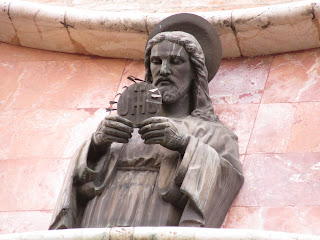




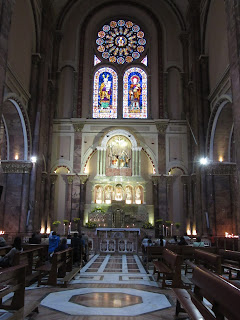



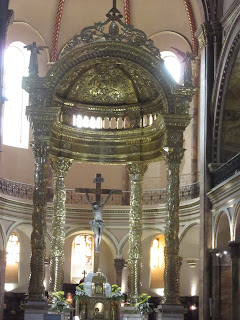

















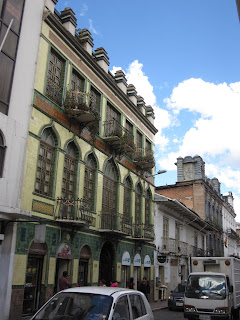



















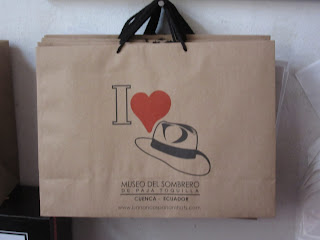









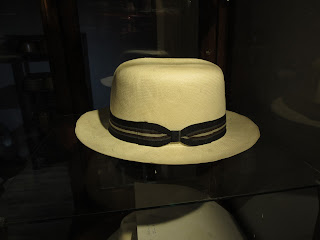


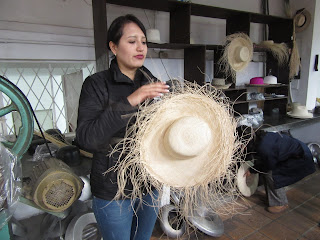
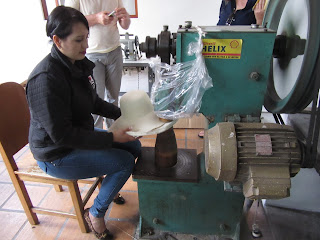




























"150 steps to the La Terraza de Santa Ana aka the roof" Oh, my aching knees. But, what a wonderful view. Lil Red
ReplyDeleteLil Red,
ReplyDeleteThere were indeed lots of step to the roof of the New Cathedral but I think the views of its stupendous domes made up for each one of the steps!
Love from Cusco, home of many more churches as you and Pat so well know!